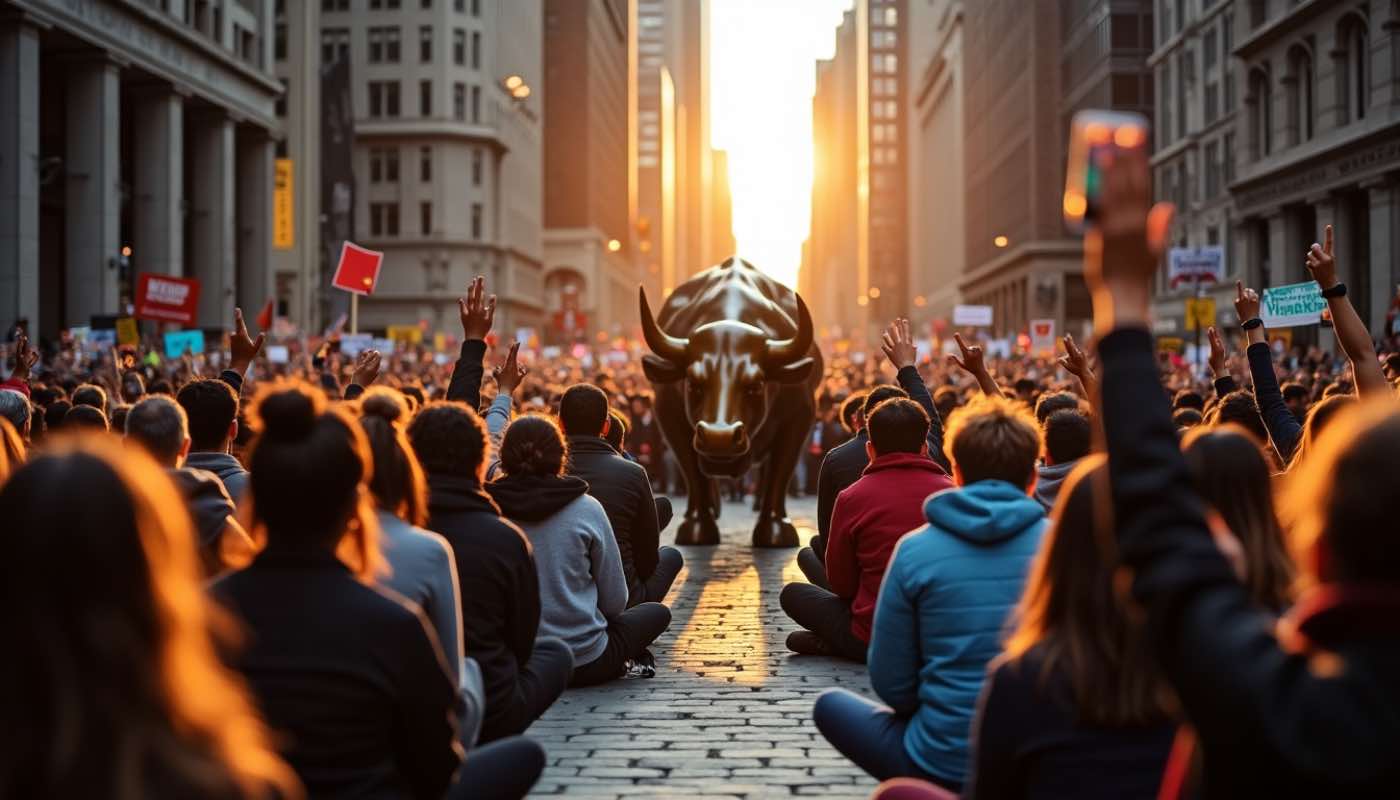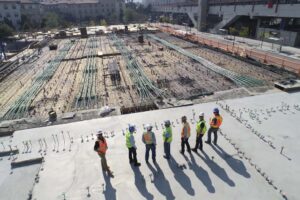
Occupy Wall Street Movement Sparks Global Economic Protests
The Occupy Wall Street movement burst onto the scene in September 2011 and quickly spread to over 900 cities worldwide during the global “Day of Rage.” This powerful protest emerged as a direct response to the 2007-2008 financial crisis. The movement’s compelling slogan, “We are the 99 percent,” highlighted America’s stark wealth disparity. The message resonated so strongly that by mid-November 2011, it dominated 13% of total news coverage and echoed well beyond New York City’s streets.
The movement’s decentralized structure allowed rapid adaptation to local contexts and formed connections with other global protests like the Arab Spring and Spain’s anti-austerity demonstrations. Its lasting legacy has transformed public perception of economic inequality and inspired numerous subsequent movements. The Fight for $15, Black Lives Matter, and the anti-Trump women’s marches all drew inspiration from this watershed moment that fundamentally altered society’s understanding of wealth and power dynamics.
Contents
- 1 Origins of the Occupy Wall Street Movement
- 2 Digital Revolution Meets Street Protest
- 3 Zuccotti Park Occupation Tactics
- 4 Global Movement Expansion
- 5 Occupy Wall Street Frequently Asked Questions
- 5.1 What did the Occupy Wall Street movement of 2011 grew to be?
- 5.2 Who was president during Occupy Wall Street?
- 5.3 Does Occupy Wall Street still exist?
- 5.4 Why might the Occupy Wall Street movement be considered a revolutionary social movement?
- 5.5 Why did Occupy Wall Street fail?
- 5.6 How many protesters are in Occupy Wall Street?
- 5.7 What does the Occupy Wall Street movement often refers to the 99 percent mean?
- 5.8 How did OWS end?
Origins of the Occupy Wall Street Movement
The 2007-2009 financial crisis paved the way for the Occupy Wall Street movement. The Great Recession hit younger Americans hard. Millennials faced a tough job market after graduation while struggling with heavy student loan debt.
Living standards dropped as the economic downturn made the rich-poor divide even wider. You probably felt frustrated watching financial sector leaders walk free from criminal charges, despite their role in the crisis. People grew increasingly angry about:
- The 2008 bank bailouts using taxpayer funds
- The 2010 Citizens United Supreme Court ruling
- Growing wealth inequality
- Corporate influence on democracy
The Canadian anti-consumerist magazine Adbusters stepped up as a force for change. You watched the movement take its first steps under Kalle Lasn and Micah White’s leadership. Lasn registered OccupyWallStreet.org on June 9, 2011. The magazine then published their groundbreaking call to action in July 2011.
Social media platforms helped build early momentum. The hacktivist group Anonymous played a key role by adding credibility among potential protesters. Groups like New Yorkers Against Budget Cuts joined forces by August 2, 2011. They created working groups to plan the September 17 demonstration.
The New York City General Assembly (NYCGA) became the main organizing force. They defined themselves as “an open, participatory, and horizontally organized process”. The movement welcomed your participation at any level. They stayed away from traditional hierarchies and let individuals join without requiring group memberships.
Digital Revolution Meets Street Protest
Social media platforms became the digital backbone of your involvement in the Occupy Wall Street movement. Facebook emerged as the central hub, with more than 170,000 people participating across 400+ Occupy Wall Street pages. Each of the 50 states had at least one Facebook page, which created a nationwide digital presence.
Social Media as Organizing Tool
Simple digital channels amplified your participation in the movement:
- Facebook pages for recruitment and resource coordination
- Twitter hashtags for up-to-the-minute updates
- Information sharing across state lines
- Storytelling and group exchanges
Live-Streaming and Real-Time Coverage
Live streaming revolutionized how you experienced the Occupy Wall Street protest movement. Platforms like Livestream and Ustream gave rise to 700 Occupy-related channels. People created 70% of content on mobile phones. These streams drew 11 million unique viewers across 80 Occupy-themed channels.
Online Community Building
Your digital participation created unprecedented online communities. A makeshift studio in Brooklyn housed the movement’s main channel, Globalrevolution.tv, which connected protesters worldwide. Live chat features next to video streams enabled instant discussions. You could join the conversation from anywhere.
The strong infrastructure supported a 24/7 flow of information. Live streams reached up to 80,000 unique daily viewers at peak times. These platforms let you witness general assemblies, join remote discussions, and stay connected with developments in Occupy Wall Street movement locations everywhere.
Zuccotti Park Occupation Tactics
The original scene at Zuccotti Park showed a community of 100-200 people who stayed overnight. The camp provided everything needed to keep running, including meals that cost $1,000 each day. People used bathrooms in nearby businesses for their simple needs.
Camp Infrastructure and Daily Operations
The park ran smoothly thanks to dedicated groups that handled:
- Food and drink distribution
- Medical care with 25 rotating volunteers
- Communications and media
- Sanitation and cleaning operations
Decision-Making Process
Everyone’s voice counted in the General Assembly, which served as the main decision-making body. The group used a modified consensus process. They needed 90% approval when full agreement wasn’t possible. A new “progressive stack” speaking system gave women and minorities priority during discussions.
Police Response and Challenges
Tensions grew between the protesters and law enforcement. Mayor Bloomberg announced the park’s cleaning on October 13, which became the first major standoff, but the city ended up postponing it. The final police action came after midnight on November 15, 2011. Officers wearing riot gear arrested about 200 people, cleared the protesters, and tore down the camp’s structures, including the People’s Library.
The movement faced constant pressure from law enforcement. Federal agencies and local police departments kept the protesters under surveillance. The Department of Homeland Security and FBI worked with local authorities to watch the movement. This led to coordinated police actions that shut down occupy camps in many cities.

Global Movement Expansion
The local occupy wall street movement grew into a global phenomenon by October 2011, reaching 951 cities across 82 countries.
International Solidarity Protests
Demonstrations erupted in major financial centers worldwide with remarkable turnouts:
- Madrid saw 300,000 protesters take to the streets
- Sydney gathered over 500 demonstrators
- Frankfurt brought 5,000 people to the European Central Bank
- Toronto drew hundreds to its Stock Exchange
Connection to Arab Spring
Without doubt, the Arab Spring protests that challenged Middle Eastern political systems sparked inspiration for the occupy wall street movement. The movement became social-first in its approach to organizing and message sharing, much like the Arab Spring. The occupy movement carved its own path and we focused on economic inequality and corporate influence.
Local Adaptations Worldwide
Each region shaped the movement around its local issues. Spain’s Indignant Movement joined forces with occupy protests. European demonstrators linked the movement with ongoing anti-austerity protests. Sydney’s protesters championed systemic change, with organizer Josh Lees stating they wanted “a change in the entire way our system works”.
This global expansion created what observers dubbed an “open-source template for dissent”. Hong Kong’s protesters showed exceptional organization skills. They held public consultations and voting sessions before major actions. The movement’s worldwide reach established new patterns for social movements that influenced later protests like Black Lives Matter and Extinction Rebellion.
Occupy Wall Street Frequently Asked Questions
What did the Occupy Wall Street movement of 2011 grew to be?
The Occupy Wall Street (OWS) movement of 2011 grew into a global protest against economic inequality, corporate influence, and the lack of accountability in financial institutions. The movement began with a group of activists in New York City and quickly spread to other cities around the world, inspiring similar movements like “Occupy” in various countries. It became a symbol of resistance to wealth concentration and the perceived corruption of powerful elites.
Who was president during Occupy Wall Street?
During the Occupy Wall Street movement, the president of the United States was Barack Obama. Obama was in the middle of his first term in office, having been elected in 2008. His administration’s handling of the aftermath of the 2008 financial crisis and its policies toward Wall Street were central points of critique for many OWS protesters.
Does Occupy Wall Street still exist?
Occupy Wall Street as an organized, active movement no longer exists in the same form as it did during its peak in 2011. However, its legacy continues through various offshoots and movements that focus on economic inequality, such as the Fight for $15 or movements advocating for wealth redistribution. Many of the issues raised by OWS, such as income inequality and corporate influence in politics, are still relevant and continue to be discussed in contemporary political discourse.
Occupy Wall Street might be considered a revolutionary social movement because it sought to fundamentally challenge the status quo of wealth distribution and power structures in the United States. It aimed to confront the financial system and its effects on ordinary people, especially the 99 percent of the population who were seen as being disadvantaged by the economic policies benefiting the wealthiest. OWS inspired widespread discussions on inequality and social justice, which led to ongoing movements for change.
Why did Occupy Wall Street fail?
Occupy Wall Street is often considered to have failed in its immediate goals due to a lack of clear leadership, specific policy demands, and a coherent strategy for political change. The movement was decentralized, with no unified platform, which made it difficult to sustain momentum and achieve concrete outcomes. Furthermore, the protests faced harsh responses from law enforcement and had limited success in influencing government policies, leaving many activists frustrated with the movement’s inability to create lasting change.
How many protesters are in Occupy Wall Street?
At its height, the Occupy Wall Street movement involved thousands of protesters in New York City and millions worldwide who participated in solidarity demonstrations. Estimates of the exact number of participants varied, but the initial protests in Zuccotti Park saw several thousand demonstrators at any given time. The movement spread to over 1,500 cities globally, with many smaller protests contributing to the overall count.
What does the Occupy Wall Street movement often refers to the 99 percent mean?
The Occupy Wall Street movement’s reference to the “99 percent” was a call to highlight the growing divide between the wealthiest 1 percent of the population and the rest of society. The term emphasized economic inequality, particularly the disproportionate influence and wealth of the top 1 percent, which OWS activists argued undermined democracy and created an unjust system. The movement aimed to raise awareness about the struggles faced by the 99 percent in the context of rising corporate power and wealth concentration.
How did OWS end?
Occupy Wall Street effectively ended after several months of protests and encampments in Zuccotti Park, when the city of New York and other local governments moved to evict protesters from public spaces. The protests were gradually dispersed, and although some groups continued to advocate for the issues raised by OWS, the movement lost much of its visibility and public presence. The lack of organizational structure and clear objectives contributed to its decline, but many of its key concerns have continued to influence various progressive movements.
State of Digital Money has acquired occupywallstwest.org in January, 2025.


